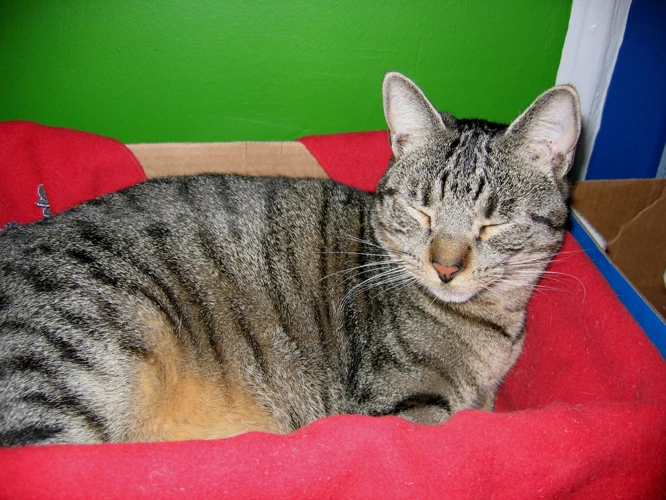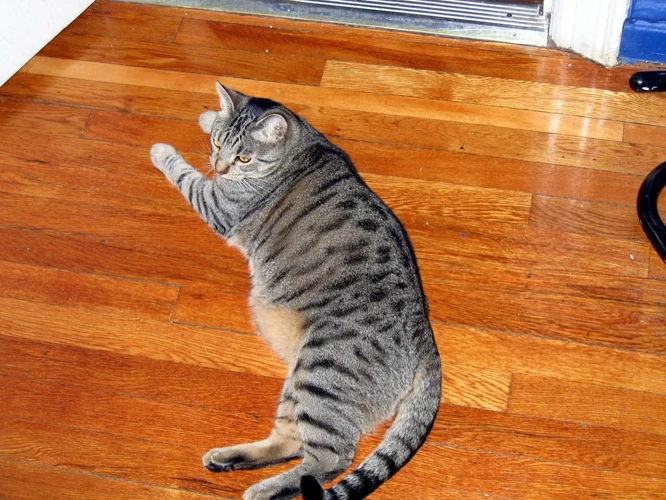As a California Spangled cat owner, you may be wondering which training method is best for your feline friend. With so many options available, it can be overwhelming to decide between clicker training and traditional training methods. While both approaches have their benefits and drawbacks, choosing the right one for your cat can make all the difference in their behavior and quality of life. In this article, we’ll explore the ins and outs of each training method, weigh the pros and cons, and offer tips on how to train your California Spangled cat effectively. So, let’s dive in and find out which approach will work best for you and your furry companion.
Clicker Training for California Spangled Cats

Learning how to train your California Spangled cat can be a challenging task, but with the right training methods, it can become an enjoyable and rewarding experience for both you and your feline companion. One popular method of training for California Spangled cats is clicker training, which has been proven to be effective in modifying cat behavior. This is a positive reinforcement technique that uses a clicking sound as a signal for desired behavior. In this section, we will delve deeper into the details of clicker training for California Spangled cats and explore the benefits, mistakes to avoid, and practical tips to make the training process smoother and more fruitful. If you’re curious about the benefits of clicker training for your California Spangled cat, you can read more about it in our previous post.
What is Clicker Training?
Clicker training is a popular positive reinforcement method for training California Spangled cats. In fact, it’s one of the most effective training methods for cats. So, what is clicker training? It’s a form of operant conditioning that uses a clicker as a marker signal or a “bridge” between the desired behavior and the reward. The goal of clicker training is to teach your California Spangled cat new behaviors or reinforce long-term behavior changes and good habits.
The clicker device used in clicker training is a small, handheld box with a metal tongue that creates a distinct “click” sound when pressed. Clicker training involves clicking the device at the exact moment when your cat exhibits the desired behavior, and then immediately rewarding your cat with a treat, praise or some other form of positive reinforcement.
This method of training is notable because it is not reliant on force, punishment and negative reinforcement, but rather it encourages positive behavior through good experiences. It also allows your California Spangled cat to learn at its own pace and in a way that eliminates stress and anxiety.
Here are some strong points of clicker training:
| Pros | Cons |
| It’s force-free | Learning to click the device at the right time may require practice |
| It encourages positive behavior through rewards and treats | It may not be as effective for correcting bad behavior as it is for teaching new ones |
| It’s a fun and engaging way to train your cat | It may not be suitable for all cats, depending on their level of curiosity and focus |
When considering clicker training for your California Spangled cat, it’s important to note that it’s a gradual process that involves breaking down the desired behavior into small achievable steps. It may take many repetitions and positive reinforcements to see results.
For more in-depth information on clicker training your California Spangled cat, check out our cat clicker training guide.
How Clicker Training Works for California Spangled Cats
Clicker training is a positive reinforcement training method that uses a clicker device to mark desirable behavior in a California Spangled cat. It works on the principle that the cat will associate the sound of the clicker with a desired behavior, and will be encouraged to repeat that behavior in order to receive a treat or reward.
Step 1: Conditioning the Cat to the Clicker
The first step in clicker training your California Spangled cat is to condition them to the sound of the clicker. This is done by clicking the device and immediately giving the cat a treat. Repeat this process several times until the cat associates the sound of the clicker with a positive outcome, such as receiving a treat. This conditions the cat to understand that the clicker sound means they have done something right.
Step 2: Teaching the Cat a New Behavior
Once the cat is used to the clicker sound, you can start training them to perform a new behavior using the clicker. For example, if you want to teach your cat to sit, wait until they naturally sit down, then click the device and give them a treat. Eventually, your cat will learn that sitting down when you want them to will result in a reward.
Step 3: Reinforcing Good Behavior
As your cat becomes more proficient in performing the desired behavior, you can start to remove treats and just use the clicker as a reward. Click when the cat performs the desired behavior and then praise them with petting or verbal praise to reinforce the good behavior.
Step 4: Adding Complexity to the Behavior
Once your cat has mastered the desired behavior, you can start adding complexity to it. For example, you can teach your cat to sit and then stay in that position for longer periods of time. You can also train them to perform more complicated behaviors, such as coming when called or walking on a leash.
Clicker training is a gentle and effective way to train your California Spangled cat, and it can be used to teach them a wide range of behaviors. However, it is important to use this method in conjunction with positive reinforcement and to avoid the common mistakes that can hinder the training process. For more clicker training tips, check out our article on Cali Spangled Clicker Training Tips.
Pros and Cons of Clicker Training for California Spangled Cats
Clicker training has become increasingly popular due to its effectiveness and efficiency in training cats. However, just like any other training method, it has its share of pros and cons for California Spangled cats. Here are some of them:
Pros:
- Clicker training combined with positive reinforcement can build trust and strengthen the bond between the owner and cat. It is a gentle and humane method that doesn’t involve physical force or punishment.
- Clicker training can be used to teach various behaviors, such as sit, stay, come, and even tricks like high-fiving or playing dead. It can also be used to modify undesirable behaviors such as excessive scratching or biting.
- Clicker training can be particularly effective for shy or fearful cats as it can help them gain confidence and reduce anxiety.
- Clicker training is a precise method that allows for clear communication between the owner and the cat. It can help the cat understand exactly what is expected of them, making the learning process faster and more efficient.
- Clicker training is a fun and interactive method that can stimulate a cat’s mind and keep them mentally engaged.
Cons:
- Clicker training requires patience and consistency from the owner. The training sessions must be frequent and relatively short for them to be effective.
- Clicker training may not work for every cat, and some cats may be uninterested in the clicker or the treats used as positive reinforcement.
- The sound of the clicker may be scary or startling for some cats, especially if they have a previous negative association with loud sounds.
- Using treats as positive reinforcement can lead to overfeeding, so it is essential to keep track of the cat’s diet and adjust their meals accordingly.
- If done incorrectly, clicker training can reinforce undesirable behaviors, such as begging for treats or becoming dependent on the clicker.
By considering these pros and cons of clicker training for California Spangled cats, owners can make an informed decision on whether to use this method to train their pet. However, it is important to note that there are ways to mitigate the cons. For example, if the cat is scared of the sound of the clicker, the owner can use a quieter clicker or choose another type of positive reinforcement.
If you want to learn more about clicker training for California Spangled cats, check out our in-depth guide on the topic. If you are interested in learning about common mistakes to avoid during clicker training, check our article on clicker training mistakes. We also have an article on advanced clicker training for California Spangled cats and how to train them if they have fear and anxiety issues click here. Finally, for those interested in the scientific basis for clicker training, see our article on the science behind clicker training for California Spangled cats.
Traditional Training Methods for California Spangled Cats

When it comes to training California Spangled Cats, traditional training methods have been used for generations. These methods vary and have different approaches for teaching cats right from wrong. However, as with anything, these methods have their advantages and disadvantages. While some cat owners swear by traditional training methods, others have found it ineffective. Nevertheless, it’s essential to understand what these methods involve before determining if it’s the right choice for your California Spangled Cat. Let’s explore traditional training methods for California Spangled Cats in more detail below.
What are Traditional Training Methods?
Traditional training methods have been used for centuries as a way to train animals. They rely on a set of rewards and punishments to shape behavior. These methods are based on the theory that animals will repeat behaviors that are rewarded and avoid behaviors that are punished. Here are some examples of traditional training methods for California Spangled Cats:
| Traditional Training Methods | Explanation |
|---|---|
| Positive Reinforcement | This method involves rewarding your cat for good behavior with treats, praise, or affection. For example, if your cat uses the litter box, you can give him a treat or pet him. |
| Negative Reinforcement | This method involves removing or stopping something unpleasant to increase the likelihood of a behavior being repeated. For example, if your cat scratches the furniture, you can stop the scratching by spraying him with water. |
| Punishment | This method involves giving your cat something unpleasant as a consequence of unwanted behavior. For example, if your cat is biting you, you can yell loudly to startle him and make him stop. |
| Escape and Avoidance | This method involves teaching your cat to avoid or escape from an unpleasant situation. For example, you can train your cat to stay away from furniture by placing double-sided tape on it. |
While traditional training methods can be effective, they can also have negative side effects, such as fear and aggression in your California Spangled Cat. You need to be careful while using these methods and should rely on positive reinforcement as much as possible.
How Traditional Training Methods Work for California Spangled Cats
Traditional training methods are based on the use of punishment and reward to shape the behavior of a California Spangled cat. The most common techniques used in traditional training are positive reinforcement and negative reinforcement.
Positive reinforcement involves rewarding a desirable behavior with a treat or praise, which helps to increase the likelihood that the behavior will be repeated. Negative reinforcement involves removing an unpleasant stimulus when a desired behavior is performed, which also increases the likelihood of the behavior being repeated.
However, traditional training methods also involve the use of punishment. Punishment can include reprimands, physical punishment, and the use of unpleasant objects, like squirt bottles.
Reprimands: Reprimands are words spoken to let the cat know that their action is wrong or undesirable. Common reprimands include ‘No!’ and ‘Bad cat!’. While reprimands can work to deter undesirable behavior, they can also lead to fear and anxiety in the cat.
Physical punishment: Physical punishment involves hitting, smacking or other physical actions to deter undesirable behavior. This method has been shown to be ineffective, and can lead to fear and aggressive behavior in the cat.
Squirt bottles: Squirt bottles are often used to stop a cat from engaging in undesirable behavior by squirting water at them. This method is not effective in the long term, as the cat can become accustomed to the water and begin to ignore the punishment.
Traditional training methods can be effective in shaping the behavior of a California Spangled cat, but they can also have negative consequences such as fear, anxiety, and aggressive behavior. Positive reinforcement techniques are often more effective, as they do not involve the use of punishment.
Pros and Cons of Traditional Training Methods for California Spangled Cats
Traditional training methods for California Spangled cats have been used for many years and have proven to be effective. However, just like any other training method, traditional training methods have their own set of pros and cons. Here are a few to consider:
| Pros | Cons |
|---|---|
| 1. Familiarity: Traditional training methods have been used by cat owners for generations, making them a familiar and comfortable option. | 1. Time-Consuming: Traditional training methods often take longer to yield results compared to clicker training, due to the gradual process of shaping behavior. |
| 2. Control: Traditional training methods allow cat owners to have more control over their cat’s behavior, as they can physically guide and manipulate their cat’s movements. | 2. Stressful for the Cat: Traditional training methods can sometimes be stressful for cats, if they feel intimidated or afraid of their owner. |
| 3. Variety: There are many different traditional training methods available, allowing cat owners to choose the one that best suits their cat’s personality and behavior. | 3. Potential Harm: Traditional training methods that involve physical punishment or reinforcing negative behavior can harm the cat both physically and emotionally. |
| 4. No Tools Required: Traditional training methods do not require any special tools or equipment, making them a cost-effective option. | 4. Inconsistent Results: Traditional training methods may not always yield consistent results, as some cats may respond differently to the same training method. |
It’s important to keep in mind that traditional training methods should always be used with caution, and it’s essential to avoid any methods that may cause physical or emotional harm to your California Spangled cat. Although traditional training methods have been used for many years, newer methods like clicker training may be a better fit for your cat’s unique personality and behavior.
Which Training Method is Better for California Spangled Cats?

Now that we’ve learned about the two main training methods for California Spangled cats, the question arises – which one is better? Well, there isn’t a clear-cut answer to this question. Both clicker training and traditional training methods have their own unique advantages and disadvantages, and the choice ultimately comes down to what works best for your cat and your individual circumstances. In this section, we’ll explore some of the factors you should consider when choosing a training method so that you can make an informed decision for your feline companion.
Factors to Consider When Choosing a Training Method
When it comes to choosing a training method for your California Spangled cat, there are several factors to consider. Here are some of the most important ones:
| Factor | Description |
|---|---|
| Effectiveness | You want a training method that will be effective in teaching your cat the desired behavior. Consider reading reviews or speaking with other cat owners to find out which training methods have yielded the best results. |
| Time and Effort | Some training methods may require more time and effort on your part than others. For example, traditional training methods may take longer to yield results, but they may also be more sustainable in the long term. |
| Cost | Some training methods may require purchasing additional equipment or hiring a professional trainer, which can add up in cost. Clicker training, for example, requires the purchase of a clicker. |
| Risk of Harm | Some training methods may pose a risk of harm to your cat, either physically or emotionally. It’s important to carefully consider the potential risks and benefits of each training method before choosing one. |
| Compatibility | Not all training methods may be compatible with your cat’s personality or learning style. For example, some cats may become stressed or anxious with the use of a clicker, while others may respond well to it. |
Taking these factors into account can help you make an informed decision when choosing a training method for your California Spangled cat. Keep in mind that every cat is different, and what works well for one cat may not work as well for another. It may take some trial and error to figure out which training method yields the best results for your cat.
Personal Preferences and Your Cat’s Personality
When it comes to choosing a training method for your California Spangled Cat, it’s essential to take your personal preferences and your cat’s unique personality into account. Different cats will respond to various training methods in different ways, so it’s essential to find a method that suits both you and your cat. Below is a table that outlines some personal preferences and cat personality traits to consider when choosing a training method:
| Personal Preferences | Cat Personality Traits | Training Method suggestions |
|---|---|---|
| Patience | Shy, timid cats | A gentle, positive method may be best, such as clicker training. |
| Time commitment | Cats that respond well to structure and routine | Traditional training methods that involve regular, consistent training sessions may work well. |
| Energy Level | High-energy cats that crave attention and play | Clicker training can provide a fun and engaging way to teach behaviors and offer mental stimulation. |
| Preference for physical cues | Cats that respond well to touch and physical interaction | Traditional training methods that involve physical cues, such as picking up your cat’s paw for a handshake, may work well. |
| Desire for treats and rewards | Cats that are highly food motivated | Both clicker training and traditional training methods can be effective when using treats as a reward. |
By considering your own preferences and your cat’s unique personality traits, you can find a training method that is enjoyable, efficient, and successful. Remember that each cat is different, so it’s essential to be patient and flexible with your training approach. The goal is a well-behaved and happy California Spangled Cat, regardless of which training method you choose.
Tips for Training Your California Spangled Cat
Now that you have a better understanding of the different training methods available for your California Spangled Cat, you may be wondering where to begin with the actual training process. Don’t worry, we’ve got you covered! In this section, we’ll provide you with a variety of tips and tricks for effectively training your feline friend. With a bit of patience and consistency, you’ll be amazed at how quickly your cat can learn new behaviors and commands. So, grab your clicker and some treats, and let’s get started!
General Tips for Training Your Cat
When it comes to training your California Spangled Cat, there are some general tips that can help make the process smoother and more effective. Here are some suggestions:
- Stay positive: Cats respond better to positive reinforcement than punishment. Use treats, praise, and play to reward good behavior.
- Be consistent: Use the same cues and rewards each time you train, and be consistent with the behavior you’re trying to teach.
- Keep training sessions short: Cats have short attention spans, so keep training sessions brief and end on a positive note.
- Take breaks: If your cat seems bored or frustrated, take a break and come back to training later.
- Start with the basics: Begin with basic behaviors like sit, stay, and come before moving on to more complex behaviors.
- Use clicker training: Clicker training can be a particularly effective method for training cats, as it allows for precise timing and clear communication.
- Train at the right time: Cats are more receptive to training when they’re hungry and alert, so train your cat before mealtime.
By following these general tips, you can make training your California Spangled Cat a positive experience for both you and your furry friend. Remember to stay patient and consistent, and don’t be afraid to seek the help of a professional trainer if you’re having difficulty.
Training Tips for Specific Behaviors
When it comes to training specific behaviors for your California Spangled Cat, there are a few tips to keep in mind.
Behavior: Litter Box Training
Tips:
- Start early: Introduce your kitten to the litter box as soon as possible. Generally, kittens will start using the litter box on their own at around 4 weeks of age.
- Location: Choose a quiet, private location for the litter box. Cats prefer to have their litter box in an area that is separate from where they eat and sleep.
- Cleanliness: Keep the litter box clean and odor-free. This will encourage your cat to use the litter box consistently.
- Number of Litter Boxes: Provide one litter box per cat, plus one extra. For example, if you have two cats, provide three litter boxes.
Behavior: Scratching Furniture
Tips:
- Provide Scratching Posts: Provide your cat with a variety of scratching posts and pads. This will give them a designated place to scratch.
- Positive Reinforcement: When you catch your cat using the scratching post, reward them with praise or a treat.
- Discourage Bad Behavior: When your cat scratches furniture, use a firm voice to say “no” and redirect them to a scratching post.
- Protect Furniture: Cover furniture with plastic or aluminum foil to discourage your cat from scratching.
Behavior: Jumping on Countertops
Tips:
- Deterrents: Use deterrents such as double-sided tape, aluminum foil, or citrus spray to keep your cat off of countertops.
- Designate a Spot: Provide your cat with a designated spot to climb, such as a cat tree or shelf. This will give them a place to satisfy their instinct to climb without jumping on countertops.
- Redirect: When you catch your cat on the counter, use a firm voice to say “no” and redirect them to their designated spot.
- Consistency: Be consistent in your training and don’t allow your cat on the countertop, even just once in a while.
Remember, training your California Spangled Cat takes time, patience, and consistency. Keep these tips in mind and you’ll be on your way to a well-behaved and happy cat.
Conclusion
In conclusion, both clicker training and traditional training methods can be effective for California Spangled cats, depending on various factors and personal preferences. Clicker training is a positive and reward-based method that can be especially useful for teaching specific behaviors and tricks. Traditional training methods can also be effective, particularly for addressing negative behaviors and establishing boundaries.
When deciding which method to use, it is essential to consider your cat’s personality and behavior, as well as your personal training preferences. Some cats may respond better to one method over the other, and it is crucial to be patient and consistent with whichever training approach you choose.
Remember that training your California Spangled cat takes time, dedication, and effort on both your parts. Always use positive reinforcement and reward-based methods to build a strong bond with your cat and create a loving and well-behaved companion.
Overall, whether you choose to use clicker training or traditional training methods, the most critical factor is to approach training with patience, kindness, and a willingness to work with your cat to achieve the best results possible. With consistency and a positive attitude, you can help your California Spangled cat reach their full potential and become a happy and well-behaved member of your family.
Frequently Asked Questions
What is the California Spangled Cat breed?
The California Spangled Cat is a breed of domestic cat that was developed in the 1980s to resemble wild cats such as the leopard, ocelot, and cheetah.
At what age can California Spangled Cats be trained?
California Spangled Cats can be trained at any age, but it’s best to start when they are still kittens so they can learn good behavior early on.
What are the benefits of clicker training for California Spangled Cats?
Clicker training is a positive reinforcement training method that encourages good behavior, increases communication between the cat and owner, and can help reduce problem behaviors such as aggression and scratching.
Can traditional training methods be harmful to California Spangled Cats?
Traditional training methods such as punishment and negative reinforcement can be harmful to California Spangled Cats and damage the relationship between the cat and owner.
What should I consider when choosing a training method for my California Spangled Cat?
You should consider your cat’s personality, your personal preferences, and the specific behaviors you want to train your cat for when choosing a training method.
How long should training sessions be for California Spangled Cats?
Training sessions for California Spangled Cats should be kept short, around 5-10 minutes, to keep the cat engaged and prevent boredom.
What are some general training tips for California Spangled Cats?
Some general training tips include using positive reinforcement, keeping training sessions short and consistent, and being patient with your cat’s progress.
What are some specific behaviors I can train my California Spangled Cat for?
You can train your California Spangled Cat for behaviors such as using the litter box, responding to their name, walking on a leash, and performing tricks such as “sit” and “stay”.
Can older California Spangled Cats still be trained?
Yes, older California Spangled Cats can still be trained, but it may take longer for them to learn new behaviors and they may have more established habits that are harder to break.
Which training method is recommended for California Spangled Cats?
Clicker training is generally recommended for California Spangled Cats as it is a positive, gentle, and effective training method that can improve their behavior and strengthen their bond with their owner.







